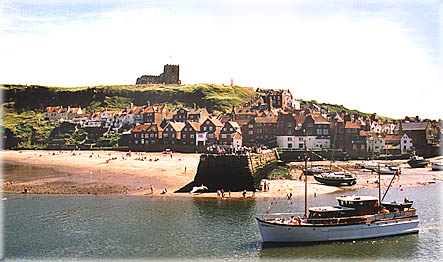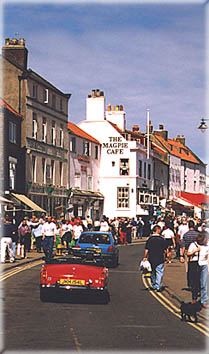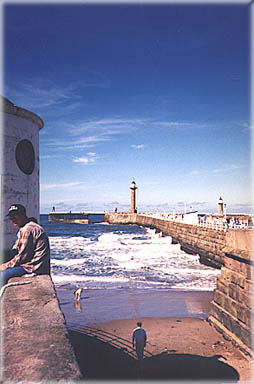SCARBOROUGH AND WHITBY
You don’t go to the Yorkshire coast to get a deep suntan. Relentless unbearable heat is not usually a problem. Swimming in the North Sea is only for the very young and the most hardy souls. Nor is sophisticated cuisine the main attraction. Scarborough and Whitby are not the first choice of the international jet set. The rich and famous take their holidays elsewhere. So, you’ll appreciate, the Yorkshire coast has much to recommend it!
Scarborough
is the largest and best known of Yorkshire’s holiday resorts. Only a limited
number of people go for a week or fortnight’s holiday though nowadays. The
North Bay is divided from the South Bay by the Castle Headland on which are
the remains of a twelfth century castle which stands over the town.
Scarborough has been here a long time. King John visited the Castle four times
between 1201 and 1216.
It
was during the eighteenth century that Scarborough was developed as a spa.
Beneficial springs were discovered in the seventeenth century and the town
subsequently became fashionable, visited principally by the upper classes
initially. The coming of the railways gave its development further impetus and
the Victorians built parks, hotels, music halls, theatres and ballrooms.
Though the Spa Company went into liquidation (no pun intended) in 1957, the
tradition of orchestral concerts and drama has since been revived together
with the restoration of the buildings.
|
|
The
South Bay is an odd though fun mix of harbour and amusement arcades, the Spa
buildings and tacky shops. The Grand Hotel is not what it was. The North Bay
is not commercialised for the most part and the long promenade is a pleasure
to walk. Last time we went there waves were crashing over the promenade and
the road; it was exciting to see the power of the sea and fun to dodge the
waves and watch as others were drenched. Up
the coast is Whitby, a fishing town and, of course now tourist resort, centred
on its harbour at the mouth of the River Esk. Despite a considerable degree of
commercialism Whitby has managed to retain much of its charm and character.
Its buildings are piled up the hillsides around the harbour, cobbled streets
remain and fishing boats still unload their catches.
|
Captain
Cook came from Whitby. Bram Stoker’s Dracula was inspired by the graveyard
here. Whitby jet has been used since Victorian times to make jewellery and
ornaments. In its day Whitby has been both a shipbuilding and a whaling
centre.
On
the headland are the remains of the thirteenth century abbey of St Hilda.
Originally this was a monastery founded in the seventh century but it was
sacked by the Vikings in 870. If one climbs the 199 steps from the harbour to
the parish church of St Mary one is rewarded with a most unusual spectacle.
Originally Norman, though altered in the eighteenth and nineteenth centuries,
the church has a wooden interior made by ships’ carpenters and it boasts a
triple-decker pulpit constructed in 1778. You have never seen a church quite
like this.
|
North
of Whitby are attractive fishing villages like Sandsend, Runswick and Staithes.
South of Whitby is Robin Hood’s Bay, so-called because the outlaw Robin Hood
is said to have kept a boat here so he could, if necessary, escape his
pursuers. Over the centuries there has been a fair amount of smuggling
associated with places like Robin Hood’s Bay and Ravenscar, above the
dramatic Beast Cliff. Rather
more sedate is Filey, down the coast from Scarborough. What I most like about
Filey is that little seems to have changed since about 1955. There is no
commercialism to speak of next to the beach. One expects to see only Hillmans,
Rovers, Humber Hawks and Morris Minors. The Crescent is a fine unspoilt
terrace of domestic buildings dating from the 1850s and looking out on to the
beach and the Brigg.
|
|
The Yorkshire coast can be enjoyably visited at any time during the year. I particularly like it in autumn and winter when the sea air is bitterly cold and invigorating and the tourists are at home in Leeds and Sheffield. Pick a bright sunny day, take in Sutton Bank and the North Yorkshire Moors on the way, call at Helmsley or Pickering for tea, and it beats spending the day raking up leaves or reading the Sunday papers.
DB



